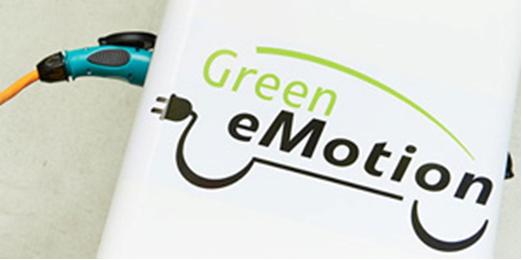The EU’s flagship electromobility project, Green eMotion, has organised for the first time an electric vehicle rally from the Green eMotion demonstration regions to Brussels. Over the past few days, five teams – EdF (Strasbourg), ESB (Belfast), RSE (Milano), TÜV Nord (Hannover), and Verbund (VIenna) – drove their electric vehicles to Brussels, using different charging stations along the way. The tour culminated on september 18th with a high-level conference with the Vice-President of the European Commission and Commissioner for Transport Mr Siim Kallas. A parallel interoperability demonstration showed that the marketplace developed within the project now allows Europe-wide access to charging infrastructure.
«Green eMotion has achieved major milestones during the 3 ½ years of project work to enable the mass market roll-out of electromobility: Prototype implementation of a really scalable, open ICT system enabling Europe-wide access to charging infrastructure, development of necessary standards for electromobility and a roadmap for future standardisation work, detailed technical work (from grid impact studies to the evaluation of electric vehicles under real life conditions) as well as the preparation of guidelines and policies,” said Dr. Heike Barlag, Siemens AG, the project coordinator of Green eMotion.
Following the keynote speech by Vice-President Kallas on the future of electromobility in Europe and the view from the electricity industry presented by EURELECTRIC Secretary General Mr Hans ten Berge, Green eMotion representatives from partners Enel, IBM and RSE explained some of the project’s successes, including the demonstration of a truly interoperable electromobility system, the setting up of a marketplace for roaming throughout Europe, and the work carried out on standardisation.
As a second highlight of the event, Green eMotion partners demonstrated their developed interoperability solution with electric vehicles and charging infrastructure from different operators throughout Europe. The charging infrastructure for the demonstration was provided by EDF, Endesa, Enel, ESB, Iberdrola and RWE. The demonstration showed how users can easily charge their electric car independently from their local infrastructure operator. This is made possible via the Green eMotion marketplace platform provided by IBM, an open ICT infrastructure developed within the project that includes a clearinghouse service from SAP for roaming. This marketplace was also used during the Rally to Brussels when the teams – running cars from BMW, Nissan, Opel and Renault – charged with their own user-ID at the charging stations of other project partners.
Other working areas of the Green eMotion project addressed by speakers in the conference included the effect of electric vehicles on the power system, sustainable business models for electromobility, increasing the acceptance of electric cars, and evaluating and influencing their range. The presentations from this conference can be found on the Green eMotion project website www.greenemotion-project.eu.
About Green eMotion: The project’s 42 partners have joined forces to explore the basic conditions that are needed for Europe-wide electromobility. The primary goal of the project is to demonstrate an interoperable electromobility system with easy access to charging infrastructure all over Europe. Such a system is only feasible with standards that can be adopted internationally. To this end, practical research is being conducted in different demonstration regions all over Europe with the aim of developing and demonstrating a commonly accepted and user-friendly framework that combines interoperable and scalable technical solutions with a sustainable business platform. The project is funded by the EU and runs until February 2015. More information is available at: www.greenemotion-project.eu


